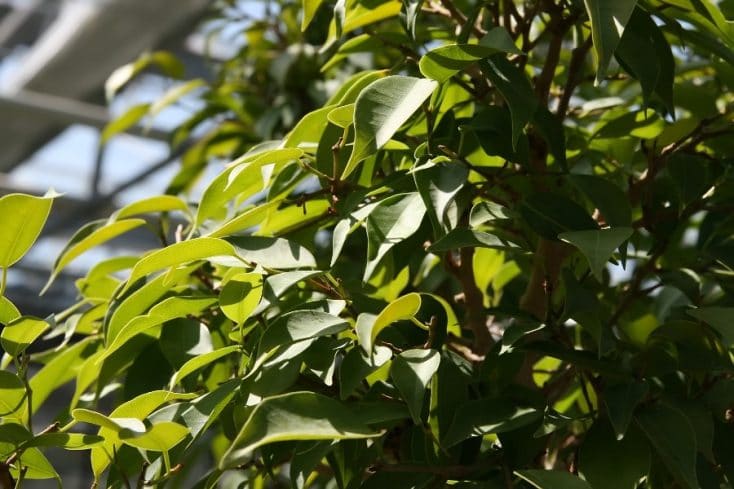Its name conjures images of sadness and grief, but the reality is that the weeping fig is a rather enjoyable plant to grow. Easily cultivated both indoors and out, the weeping fig – or Ficus
How to care for a weeping fig: Weeping figs should be grown in bright light at 65 to 75 °F, in fast draining soil. Water to keep the soil lightly moist and maintain humidity between 50 to 70%. Fertilize monthly from April to September. Avoid moving or repotting unnecessarily as this causes leaf drop.
If you’ve just acquired a weeping fig tree, or are having problems looking after your plant, read on as I go into the detail of how to keep a weeping fig tree happy and healthy.
Weeping Fig Tree Overview
Part of the Ficus plant genus, the weeping fig is an attractive indoor plant. It has arching branches and long pointed leaves, and while it doesn’t usually produce flowers or fruit when grown indoors, it is a simple-to-care-for plant that grows with relative ease.
This plant has a modest appearance and is offered at a reasonable price. A sharp contrast to many of the trees that you can choose to grow in your home. As a ficus, this plant produces a hard, resilient trunk and branches with bright green leaves. Overall, it’s easy to care for and is a great option for growing indoors.
Ideal Growing Conditions for Weeping Fig Trees
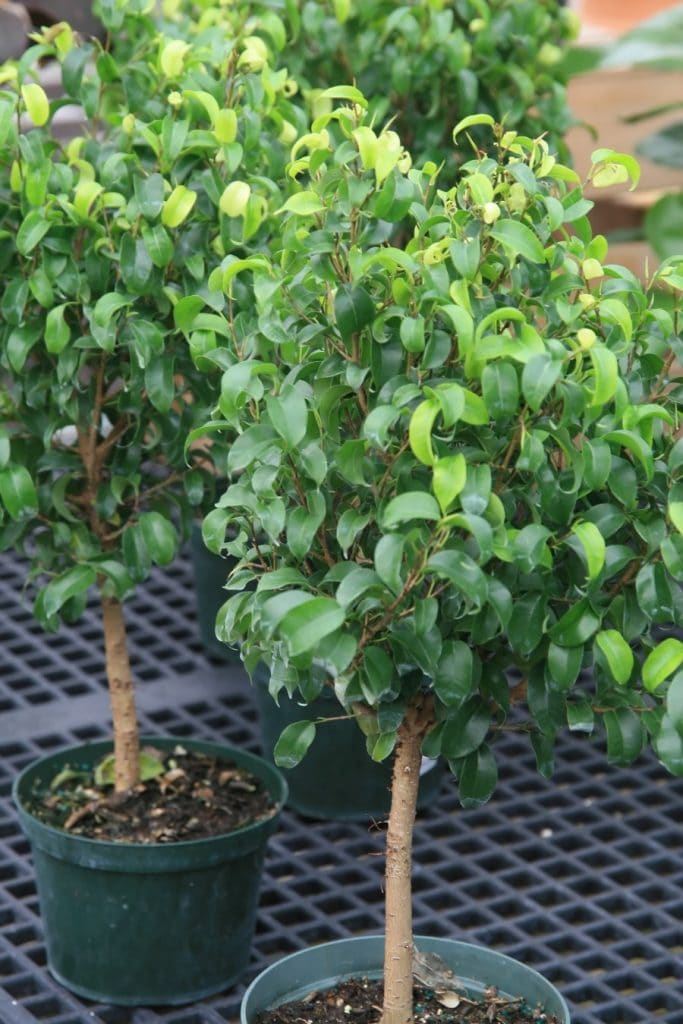
Weeping Fig Light Requirements
Weeping figs prefer to be kept in bright sunlight, ideally with a bit of direct sun in the morning hours. Although it is often grown in a shady location when cultivated outside, when grown in a more controlled indoor setting, it needs more light to thrive.
That being said, you don’t want to give your plant too much midday sun. Early morning or late afternoon sun, particularly filtered sunlight, is the best bet. A spot that provides some sun as well as some controlled shade during the day is even more ideal. Resist the temptation to rotate your plant if it looks as though it is growing unevenly, as moving the tree can cause it to shed leaves.
They also need to be kept relatively warm. If you can, maintain your room’s temperature between 65 to 75 °F (18 to 24 °C), and if you must fluctuate, warmer is always better. Temperatures below 50 °F can be devastating for your ficus plant.
Although these plants can sometimes survive cooler weather, cold temperatures cause a shock that can be very damaging and irreversible. Keep your plant in a location that will not be exposed to cold drafts.
Watering Weeping Figs
You should water your weeping fig regularly, keeping it steadily moist. As previously mentioned, the soil can’t be too waterlogged, as the plant will begin to drop leaves and can also suffer from fungal diseases like root rot. Let the soil dry out somewhat between each watering. When you water, use either filtered or distilled water that is room temperature to prevent shock.
If you notice that your plants’ leaves have become crunchy or bend easily, then you are not watering correctly. Crispy, crunchy leaves indicate underwatering, while leaves that fold too easily could be overwatered. When you water, make sure that some seeps from the topsoil to the drainage holes, and then remove any water if there is some left over after watering. During the winter, you can water less regularly.
Weeping figs can tolerate some mistakes in regards to watering, so if you are a forgetful gardener, you shouldn’t have too much trouble keeping your plant alive. That being said, you want to make sure your plant’s soil is neither soggy or bone-dry.
Weeping Fig Soil
Weeping fig trees prefer well-draining potting soil. The best pH for your plant will be between 6.0 and 6.5 Anything with a lower pH will be too acidic, causing your tree to decline in health. Do not use any soils labeled for azaleas or roses, as these will naturally be too acidic.
Make sure your soil drains well, as weeping figs are particularly sensitive to overly waterlogged soils. You don’t want your roots to become soggy, so a thick soil will be too challenging for a weeping fig to grow in.
Weeping Fig Humidity Requirements
Weeping fig trees need high humidity levels of 50 to 70 percent. Leaf loss can be an indicator of a number of ailments, but lack of humidity is a frequent culprit.
To maintain adequate humidity, particularly in the dry winter months, you can place a humidifier near the plant. Filling a saucer with pebbles and water, and then placing the plant atop the saucer, can also be an effective way to keep your plant humid without risking it becoming too wet. In the droughts of summer or the stale air of winter, you may need to mist its leaves.
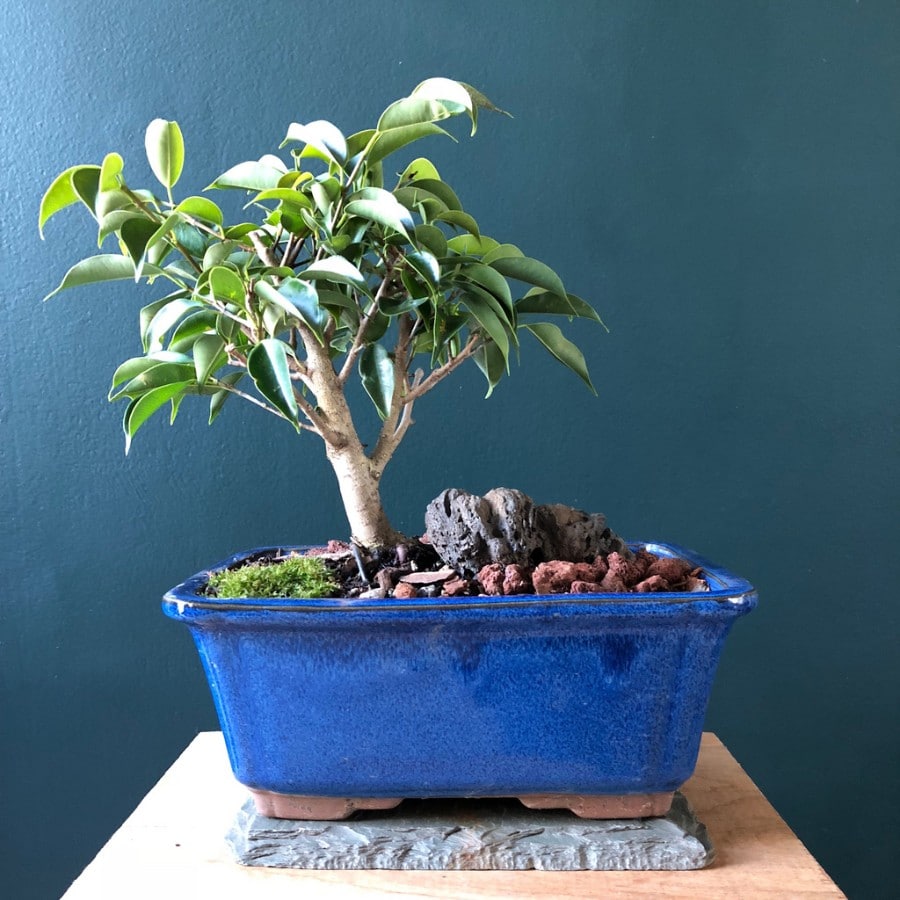
Ventilation
Air flow is also important in growing a weeping fig plant, as it is with all other indoor species. When you are growing a plant indoors, it does not have access to the gentle winds and weather patterns of the great outdoors. As a result, it is easy for the air around your plant to become stagnant and for poor airflow-related issues to arise as a result. For example, a weeping fig with too little oxygen may start to develop fungal growths or experience a drop off in growth.
To prevent this, make sure your plant is located in an area with plenty of access to a light breeze. You don’t want to expose your plant to irregular cold drafts that will cause a swing in temperature, but you can put a fan on a low setting near your plant to help circulate the air.
How To Fertilize Weeping Figs
Fertilize your plant on a regular basis. You will need to feed your weeping fig several times throughout the growing season. Regularly fertilizing your plant during the growing season will help your plant weather a winter spent indoors.
Ideally, you should fertilize once a month between April and September. Use a diluted fertilizer, and avoid fertilizing between October and March. You can use a light application of a general-purpose houseplant fertilizer but only apply it at about half the rate indicated on the package.
Propagating Weeping Figs
Although it is rare to grow weeping figs from seed, they are easy to propagate from cuttings. The best time to do this in the spring, when you can supply warmth and moisture, but before the plant has begun to put on a resurgence of new growth.
It is easiest to propagate weeping figs during the summer months. You can do this with a few inches of branch cuttings from the tips of the plants, placed into the soil. Propagating is easier when the stems are young and supple, as opposed to when they are older and woody.
To do this, simply cut a stem about an inch or two in length. Remove some of the leaves – all you need is two or three to get the plant going. Put the cutting into a new pot, surrounding it with fresh potting soil.
While the plant is getting reestablished, you will need to keep it warm and moist. While many people are able to provide enough heat just in the room’s natural environment, others may need to add some supplementary bottom heat. You can use a heated propagator or add a heat mat to do this.
Many gardeners also use a rooting hormone to improve the propagation success, although this is by no means necessary. New leaf buds will begin to form in about a month, or even quicker if a hormone is used. If you are hoping for a bushier appearance to your new plant, consider taking several cuttings and growing them together as one plant – just keep in mind that you will need to repot this group more quickly than if you grow just one in a pot.
Weeping figs grow relatively quickly, changing in shape and size as they do so. It can quickly outgrow the surrounding space, meaning you may need to prune or repot it to help it fit with its current surroundings.
Most indoor weeping fig trees will grow to a maximum height of about six feet, but they can be kept much smaller with pruning or grown as bonsai trees. There is
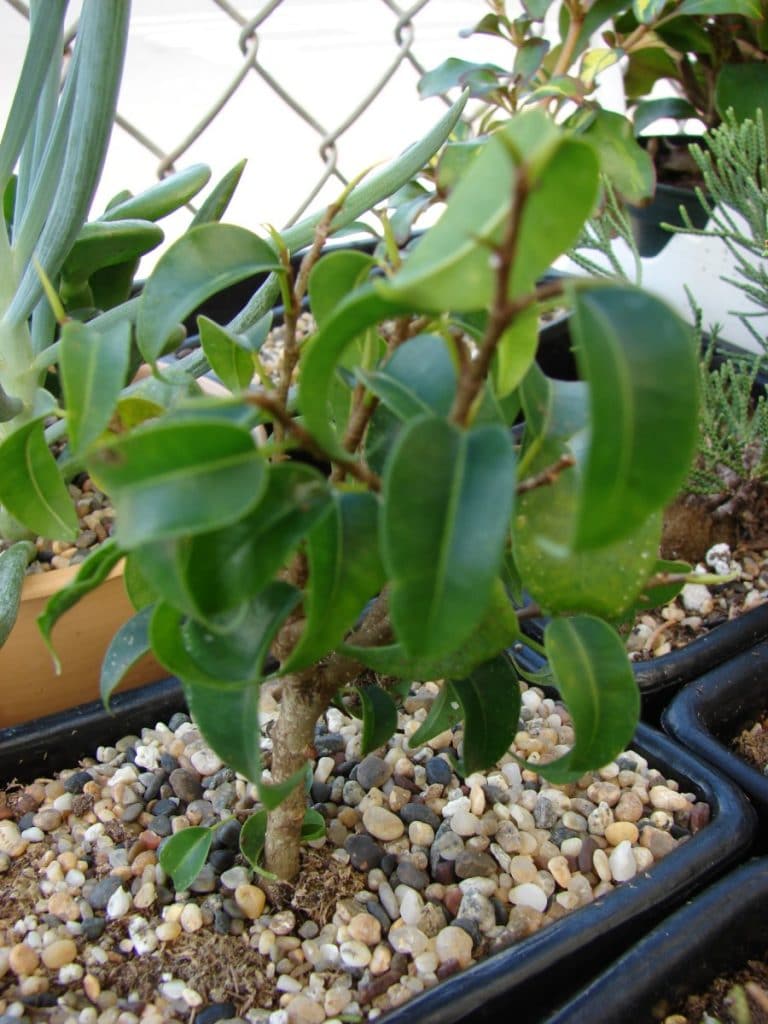
Repotting Weeping Figs
If you choose to grow a weeping fig, keep in mind that you will need to repot it several times throughout its lifespan. When your plant is young, more regular repotting will be needed, as this time period is the most rapid period of growth in a weeping fig’s life. They will need new space for their roots to sprawl.
Once they become mature, they will need less frequent repotting. Most gardeners will repot their weeping figs once every couple of years, so as to reduce the likelihood of disturbing the plant’s delicate roots. You should watch it carefully for signs that it is ready to be repotted.
As your weeping fig continues to age, it will need even less frequent repotting. Repotting too often can cause your plant to drop leaves. Instead of repotting after your plant has reached advanced age, just scrape off the top inch of soil and top dress it with compost when you would normally repot.
The process to repot your weeping fig is simple. Select a container that is well-draining, and is about two inches larger in diameter than the plant’s current pot. Fill the container with about two inches of potting soil, and then remove the plant from its current pot by applying pressure to the pot from the outside. This will help to gradually and gently loosen the roots and the dirt they are packed in.
Next, lay the tree on its side. You should keep the pot somewhat elevated as you do this. Gently massage the roots, removing as many clumps of dirt as possible. Pull the larger roots free, being careful as you do so. This will help prevent tearing and transplant shock. Place the plant into a new pot, and fill it with new potting soil.
Watering immediately after repotting is essential. Allow the plant to soak up as much moisture as possible, and then water once per week or more often, depending on how dry your home is.
Pruning Weeping Figs
Pruning and grooming your tree on a regular basis is a good idea and will get you into the habit of maintaining it. You can prune your tree to whatever size and shape suits the space you are growing it in, allowing you to customize its appearance depending on your preferences.
The best time to prune is after summer has passed, but before the next spring, when it will put on new growth. You can prune away any dead material throughout the rest of the year as well by simply cutting the plant into shape.
Try not to be too aggressive with your cuts, never removing more than a third of the plant at a time. In addition, you should take care not to shear the main woody portions of the stems.
Leaf Dropping
One of the most common problems related to growing weeping figs is its tendency to drop leaves. In fact, this is one of the most often-reported reasons for gardeners giving up on their cultivation of indoor ficus plants. They shed leaves whenever they are moved or even when there are variations in watering or sunlight patterns.
To an extent, leaf dropping is normal. These plants are native to the tropics, in which there are pronounced wet and dry seasons. As a result, these plants are adapted to drop their leaves at the beginning of the dry season. This makes them sensitive to changes in moisture in particular, but also to being moved.
Weeping figs also want their leaves in certain places to help maximize the process of photosynthesis. When you move your plant, you change the light dynamics that impact the plant, and as a natural response, the plant will drop leaves and grow new ones at the angles it deems the most efficient for photosynthesis. This can cause your plant to have an odd, unshapely appearance.
Avoid moving your plant by selecting the most ideal position for it initially and leaving it in this position. Try to pick a location that is free of draughts and which provides your plant with even, consistent levels of sunlight.
If you’re maintaining a strict, consistent watering schedule and taking care not to jostle your plant, but it’s still dropping leaves, you might try giving it a bit more sunlight. Smaller and younger plants are less likely to drop leaves, so if your plant is of advanced age and continues to drop leaves, it may be time to replace it.
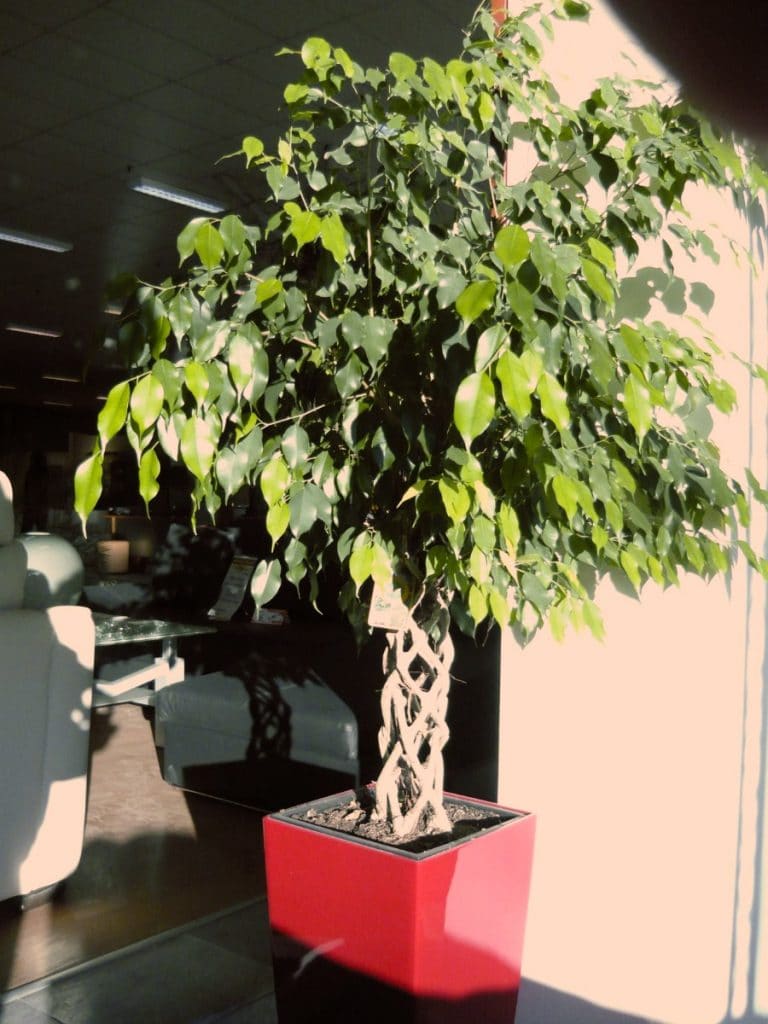
Similarity To Other Ficus Varieties
Weeping figs are often confused with similar houseplants, including the longleaf fig, fiddle leaf fig, and rubber plant. Though they are all closely related (as they are all part of the Ficus family), they have several notable differences. The longleaf fig produces leaves that are ten inches long and taper to a narrow point. This plant holds its leaves better than the weeping fig.
The fiddle leaf fig has dull, fiddle-shaped leaves that grow to up to fifteen inches in length. Rubber plants, too, are commonly grown as houseplants, but have springier, denser leaves than the weeping fig.
Types of Weeping Figs
Weeping figs are native to southeast Asia, but there are several varieties and cultivars of this plant besides what are found indigenously in this region. Each cultivar has a distinctive leaf color and pattern, with many varying in size as well.
There are several popular cultivars, including Bushy King, Danielle, Judith, Midnight Lady, Wasana, Golden King, De Gantel, Exotica, and Too Little, just to name a few. Bushy King grow small leaves with narrow edges, growing into a dense, compact plant.
Danielle, on the other hand, has sturdier leaves in a deeper green color. It produces pendulous growth and is very resistant to leaf drop, a common ailment among weeping fig trees. Judith is another small-leafed variety of this plant, producing a full shape even when grown in minimal light.
Midnight Lady grows in a compact manner similar to Bushy King, but its leaves are exceptionally dark and curly – hence the name. Wasana weeping figs are noted in particular for their excellence as a bonsai plant, producing shiny green and white leaves. It produces irregular growth and is most suited to the “weeping fig” name, as its branches appear to be hunched forward in mourning.
Golden King weeping figs have narrow bands of yellow around each leaf, while De Gantel plants have bands of chalky white. Exotica plants have light green leaves and grow in a pendulous fashion, while Too Little is the tiniest of all weeping figs. This weeping fig is perfect for indoor bonsai cultivation, possessing small glossy leaves on twiggy branches.
Once you’ve selected the best cultivar of weeping fig for your purposes, keep in mind that there are multiple methods for growing weeping figs in your home. You can cultivate it is a tall indoor tree, allowing it to develop elegantly braided trunks without leaves, or you can grow it as a shorter topiary plant. It can even be grown as a bonsai plant!
Indoor vs. Outdoor Cultivation
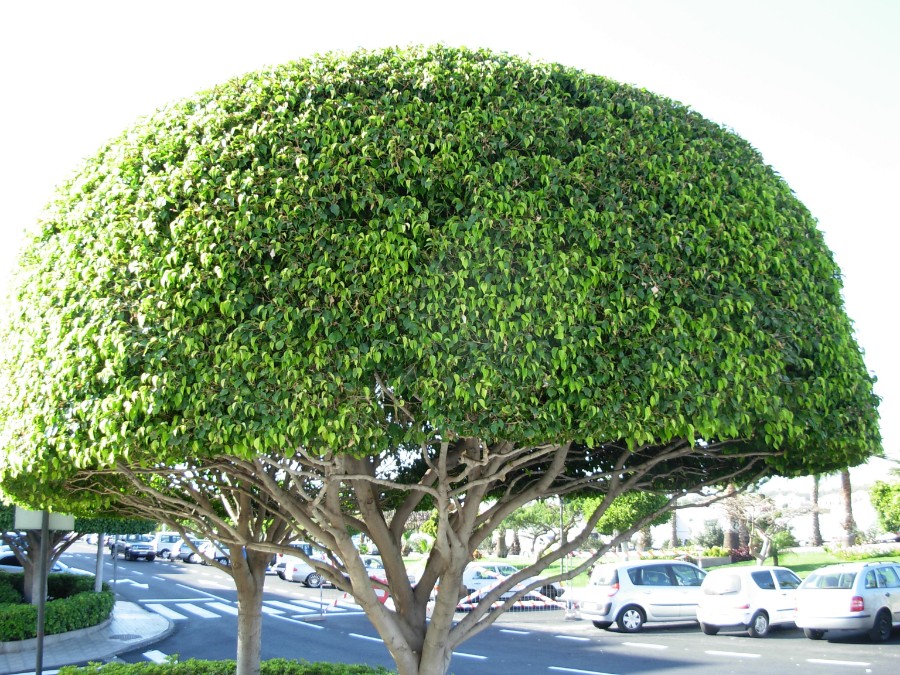
When grown indoors, weeping figs look great as a corner plant or even out on a patio. You have likely seen these plants decorating offices or hotel foyers, where they serve as elegant, low-maintenance statement pieces. While most weeping figs are grown as larger indoor trees, you can also find them as smaller fig and bonsai types, as well as being grown in select outdoor locations.
While this plant can be a bit messy when grown indoors, it requires minimal attention and can thrive in just about any corner of the world. As an outdoor plant, weeping figs are equally easy to grow, but you need to have the perfect conditions required to do so.
If you’ve successfully grown a weeping fig inside, it does not necessarily mean you will have equivalent success in moving it outdoors. In fact, many nurseries actually recommend that you consider indoor and outdoor weeping figs as completely separate species.
When grown indoors, weeping figs will not usually grow taller than six feet. However, when they are grown outdoors, weeping figs can grow up to 100 feet tall and 50 feet wide, making them a popular species to cultivate for use in a hedge. However, they can only thrive in zones 10 and 11, making them impossible to grow in any climate that is not tropical throughout the year.
No matter how you choose to grow this plant, know that the leaves on the plant will never be show-stopping in their flowers or fruits, which they aren’t likely to produce. These plants are more attractive and well-known for their shape and style, growing into an elegant tree-like appearance that adds tranquility and calm to any living space.
Pests And Diseases
Weeping figs are also susceptible to several pests, including mealy bugs, whitefly, scale, and aphids. Because this plant has so many leaves – part of what makes it so beautiful, of course! – it also provides plenty of hiding spots for damaging pests.
Scale insects are common pests for the weeping fig, using their piercing mouthparts to suck sap from the plant. These tiny pests release a sticky substance as they feed that can attract other pests, like ants, and cause mold to develop. If your plant is affected by scale insects, you might notice that its leaves are yellowing or becoming deformed.
Scale can be controlled by various methods, including pruning affected branches, picking or rubbing the pests off, using rubbing alcohol or neem oil, or using commercially available pesticides.
Mealybugs are also common indoors. These pests are less than a quarter of an inch long and have bodies coated with a wax-like substance. These pests feed voraciously, stunting your plant’s growth and causing premature death. For more information about getting rid of mealybugs, read this article here.
In some cases, you may notice your plant has tiny white spots on their leaves in a fairly regular pattern. If the spots are circular and waxy to the touch, they are nothing to worry about. These are common in ficus plants, and generally, don’t indicate anything is wrong at all.
Some scientists have suggested that these white spots are a way for the plants to get rid of accumulated slats, minerals, and toxins. Others speculate that they could be designed to attract beneficial pollinators (which of course you won’t have indoors). These spots aren’t dangerous and will disappear on their own with time, but if they bother you, you can wipe them off with a wet rag without worrying about damaging your plant.
Related Questions
Are Weeping Fig Trees Poisonous?
As a ficus, the weeping fig produces sap that can be mildly toxic to pets and people. It produces a milky sap that can cause stomach issues if ingested and mild skin irritation if the sap gets into a cut or abrasion. Otherwise, it is nothing to worry about.
Why Do My Weeping Fig’s Leaves Have Yellow Edges?
Yellowed leaf tips can be caused by a variety of situations, but in most cases, yellow leaves indicate a nutritional deficiency. You will need to feed your plant, but don’t overcompensate by overfeeding. Instead, begin a consistent routine of fertilizing your plant on a regular basis.

